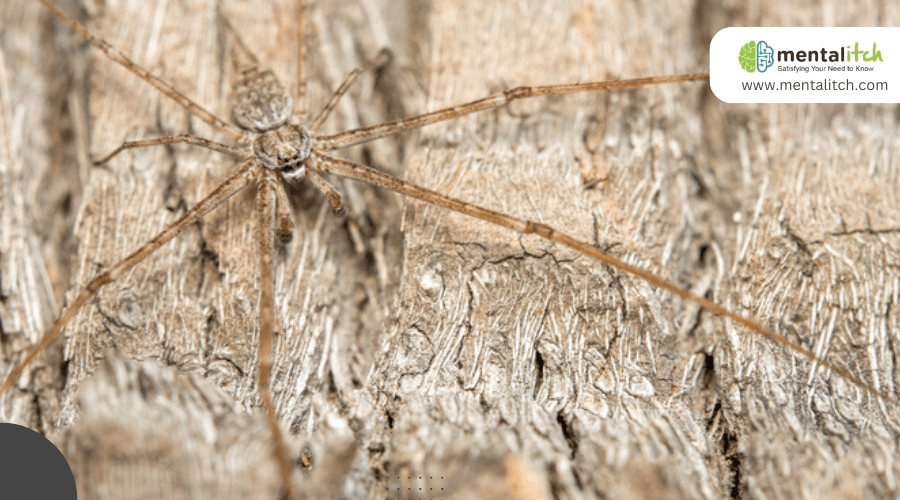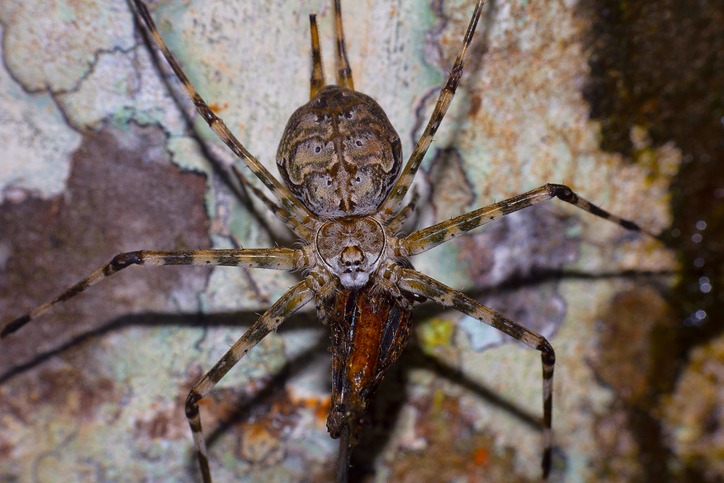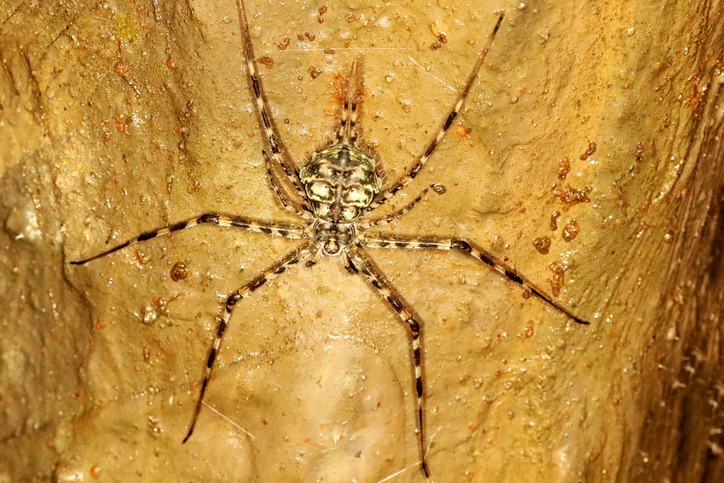Imagine you’re walking through a dense forest, and you stumble upon a creature as elusive as a shadow—a Two-tailed Spider, master of camouflage and agility. You’ve likely overlooked these fascinating beings, which blend seamlessly into their surroundings, thanks to their distinctive physical features like long spinnerets and cryptic coloration.
As you learn more about their unique hunting methods and survival adaptations, you’ll find there’s much more to these spiders than meets the eye. Why not explore the intriguing world of the Two-tailed Spider further? There’s a whole domain of secrets waiting to be uncovered, and you might just find yourself captivated by the mysteries they hold.
Distinctive Physical Features
Two-tailed spiders stand out due to their long, tail-like spinnerets and a unique, slender body shape, enabling perfect camouflage against tree bark and rock surfaces. Their long spinnerets, resembling tails more than traditional spider silk-spinning organs, set them apart in the arachnid world. You’ll find their distinctive physical features fascinating, as these adaptations are not just for show. The spiders’ elongated and narrow abdomens, coupled with their brownish coloration, allow them to blend seamlessly into their surroundings, making them nearly invisible against the backdrop of tree trunks and rocky terrains.
Additionally, their long, slender legs are often banded, adding another layer to their excellent camouflage. This not only helps them evade predators but also aids in surprising their prey. The thin, flat abdomen of these spiders is a key feature in their ability to lie flush against various surfaces, particularly dry bark, where they prefer to reside. Their ability to mimic the textures and colors of tree trunks and rocks is truly remarkable, showcasing an evolutionary masterpiece of adaptation for survival.
Habitat and Distribution
Having explored the distinctive physical features of two-tailed spiders, let’s now consider where these remarkable creatures make their homes. You’ll find these spiders in tropical and subtropical regions across the globe. Their preferred habitats are not vital; they are carefully chosen environments that provide camouflage, safety, and abundant food.
Two-tailed spiders thrive in areas where they can blend into their surroundings. Here’s what you need to know about their habitat and distribution:
- They favor regions with dense vegetation, trees, and gardens which not only offer camouflage but also house a variety of potential prey.
- Forests and areas with ample prey are prime locations for these spiders to set up their delicate webs.
- Their distribution covers a wide range of continents, including Asia, Africa, Australia, and the Americas, showcasing their adaptability.
The choice of habitat is essential for two-tailed spiders, enabling them to master the art of concealment. Whether it’s the leafy confines of a garden or the dense canopy of a tropical forest, these spiders make their homes in environments that support their unique lifestyle.
Unique Hunting Methods
While mastering the art of camouflage, two-tailed spiders also employ a unique silk-throwing technique to ensnare their prey. These spiders build their hunting strategies around the element of surprise, using their incredible ability to blend into their surroundings. Once an unsuspecting victim comes within reach, they spring into action, showcasing their fast movements. They don’t just wait for their prey to come to them; they actively engage by throwing silk, spun from their spinnerets, to immobilize it.
You might wonder how effective this method really is. Well, it’s their spinnerets that make all the difference. These specialized organs allow the spiders to produce silk, which is important for their hunting. They use this silk not only to capture but also to confine their prey, running circles around it and continuously throwing silk to make it cannot escape. This method is remarkably efficient for capturing small invertebrate prey, making the two-tailed spider a formidable hunter.
Their unique hunting methods, involving strategic use of silk and fast movements, highlight the remarkable adaptations spiders have developed for survival. It’s these adaptations that enable them to capture their prey with such precision and efficiency.
Reproductive Strategies
Beyond their unique hunting techniques, two-tailed spiders also exhibit intricate behaviors when it comes to reproduction. The complex courtship rituals and the important role of males in mating are fascinating aspects of their life cycle. Here, you’ll discover how these spiders guarantee the continuation of their species through carefully evolved reproductive strategies.
- Courtship rituals: Two-tailed spiders engage in elaborate courtship rituals, where males perform specific behaviors to attract females. This can include visual displays, vibratory signals through silk, or offering gifts.
- Male courtship behaviors: The males play a vital role in reproduction, employing various tactics to win over a mate. These behaviors are not only about attracting females but also about avoiding being mistaken for prey.
- Silk sacs: Females lay their eggs in protective silk sacs. These sacs provide a safe environment for eggs, guarding them against predators and harsh environmental conditions, ensuring they can develop undisturbed.
- Offspring survival: The female’s role doesn’t end with laying eggs; she guards these silk sacs until the spiderlings hatch. This maternal behavior significantly boosts the chances of offspring survival, safeguarding the future generations of two-tailed spiders.
Understanding these reproductive strategies highlights the complexity and adaptability of two-tailed spiders, showcasing the lengths they go to for the survival of their species.
Survival Adaptations
Two-tailed spiders possess a range of survival adaptations that allow them to expertly navigate their environment and secure prey. These remarkable arachnids have evolved features that make them adept hunters and masters of disguise. Their elongated spinnerets play an important role in silk production, essential not just for constructing intricate webs but also for capturing prey with precision. Additionally, their flat bodies and cryptic coloration enable them to blend seamlessly into their surroundings, making them nearly invisible to both prey and potential threats.
Their exceptional agility and speed are key to their hunting strategy, allowing them to ambush unsuspecting invertebrates with remarkable efficiency. This ability to move swiftly and silently through their habitat underscores their prowess as predators.
| Adaptation | Benefit |
|---|---|
| Elongated spinnerets | Enhanced silk production for web construction and prey capture |
| Flat bodies and cryptic coloration | Effective camouflage against tree bark and rock surfaces |
| Agility and speed | Superior ambushing capabilities for catching prey |
These survival adaptations underline why Two-tailed spiders are among the most efficient and adaptable hunters in the arachnid world, showcasing the diversity and ingenuity of nature’s designs.
Threats and Predators
Despite their impressive survival adaptations, two-tailed spiders are not immune to threats from predators like scorpions, jumping spiders, and redback spiders. These natural threats are a constant challenge in their habitat, posing significant risks to their survival. Sensitivity to spider venom means that, depending on the predator, two-tailed spiders can experience a range of symptoms, from mild to lethal.
Understanding the predator-prey dynamics is vital for these spiders. They’ve adapted various strategies to avoid or defend against these threats, showcasing the intricate balance of survival in their ecosystem. Here’s how they manage:
- Camouflage: Blending into their surroundings to avoid detection.
- Speed: Quickly escaping from potential threats.
- Venom: Using their own venom to defend against smaller predators.
- Nest Building: Constructing intricate webs that serve as both home and trap.
These adaptations highlight the two-tailed spider’s resilience against predators and their sensitivity to venom. However, the constant presence of these natural threats underscores the precarious balance of predator-prey dynamics within their environment. Adapting to these challenges is not just beneficial but essential for the two-tailed spider’s survival amidst the dangers posed by their natural predators.
Human Interactions
When it comes to human interactions, two-tailed spiders play a beneficial role by helping control pest populations in homes and gardens. These spiders, with their distinct characteristics, are generally important to humans and focus on preying on small insects. This not only aids in natural pest control but also indicates if there’s a larger insect infestation problem in your area.
Though their bites can cause mild symptoms like pain and swelling, severe reactions are rare. If you ever experience severe symptoms or believe you’re allergic to their venom, it’s essential to seek medical attention promptly. Despite these mild risks, the presence of two-tailed spiders around you is overwhelmingly positive due to their role in maintaining a balanced ecosystem.
Additionally, observing these spiders can offer insights into fascinating behavior, such as how a female accepts the male’s advances. This aspect of their interaction provides a glimpse into the complex lives of these often misunderstood creatures. Understanding and appreciating the role two-tailed spiders play can enhance your perspective on the natural world and the interconnectedness of all its inhabitants.
Conclusion
To sum up, you’ve learned that the two-tailed spider stands out due to its small, flat body, long spinnerets, and cryptic coloration, perfectly blending into its environment. It’s a master at ambushing prey, utilizing its speed, agility, and unique hunting techniques. These spiders thrive in their habitats by adapting impressively, though they face threats from predators and human interactions. Understanding their characteristics, from physical features to survival strategies, highlights their significance in the ecosystem, sparking further interest and research in their fascinating world.



